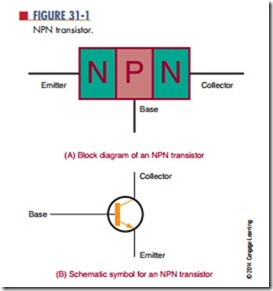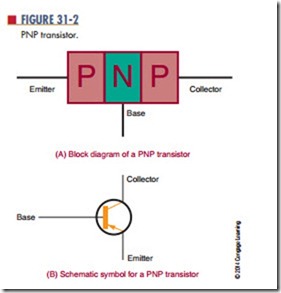In 1948, Bell Laboratories developed the first working junction transistor. A transistor is a three-element, two-junction device used to control electron flow. By varying the amount of voltage applied to the three elements, the amount of current can be controlled for purposes of amplification, oscillation, and switching. These applications are covered in Chapters 38, 39, and 40.
Transistor Construction
When a third layer is added to a semiconductor diode, a device is produced that can amplify power, current, or voltage. The device is called a bipolar transistor, also referred to as a junction transistor or transistor. The term transistor will be used here.
A transistor, like a junction diode, can be constructed of germanium or silicon, but silicon is more popular. A transistor consists of three alternately doped regions (as compared to two in a diode). The three regions are arranged in one of two ways.
In the first method, the P-type material is sandwiched between two N-type materials, forming an nPn transistor (Figure 31-1). In the second method, a layer of N-type material is sandwiched between two layers of P-type material, forming a PnP transistor (Figure 31-2).
In both types of transistor, the middle region is
called the base and the outer regions are called the emitter and collector. The emitter, base, and collector are identified by the letters E, B, and C, respectively.
Questions
1. How does the construction of a transistor differ from the construction of a PN junction diode?
2. What are the two types of transistors?
3. What are the three parts of a transistor called?
4. Draw and label the schematic symbols for an NPN transistor and a PNP transistor.
What are transistors used for?

